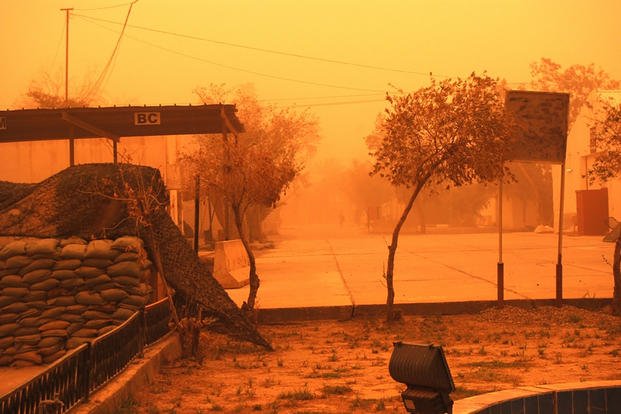The Department of Veterans Affairs plans to create a diagnostic code to ensure that veterans with constrictive bronchiolitis, an illness linked to burn pits and other airborne pollutants, can receive a disability rating and related compensation for the condition.
But the proposal, published Sept. 12 in the Federal Register, doesn’t add any new standards or criteria for evaluating veterans for the difficult-to-diagnose disease, an omission critics say will shortchange veterans.
Constrictive bronchiolitis is one of 23 diseases listed in the PACT Act as presumed to be caused by exposure to burn pits and particulate matter inhaled by troops who served in Afghanistan, Iraq and elsewhere overseas. As a presumptive condition, it is supposed to be fast-tracked in the VA’s disability claims system, with affected veterans having an easier time applying for and receiving compensation for the condition.
Read Next: Trump Vows to Restore Fort Liberty’s Old Name Honoring Confederate General
It was the only illness listed in the legislation that did not have a diagnostic code in the VA’s Schedule for Rating Disabilities, meaning that afflicted veterans could not receive a disability rating specifically for the disease. Instead, the VA has been awarding a disability rating to affected veterans under closely related respiratory conditions.
Under the proposed federal rule, constrictive bronchiolitis would have its own diagnostic code, 6605, and to evaluate a veteran for the illness and related disability, the VA plans to continue using pulmonary function tests and cardiopulmonary exercise tests, which look at the lungs, heart and circulatory system.
But medical experts and advocates say these tests are not sufficient to diagnose constrictive bronchiolitis — scarring and inflammation of the lungs’ smallest airways — and they had been hoping for new diagnostic criteria.
“The small airways have been referred to for decades as the ‘silent zone’ of the lungs, meaning that if you have scarring of the lungs, you can detect it. If you have asthma, you can detect it. But if you have something strictly limited to the small airways, it’s very difficult to detect,” Dr. Robert Miller, a professor at the Vanderbilt University School of Medicine who was among the first medical providers to diagnose the condition in U.S. service members, said during an interview with Military.com.
Because of its difficulty to diagnose, advocates had hoped the VA would not only include new evaluation criteria but would establish centers of excellence in the VA hospital system with experts who understand the illness.
The VA has six Post Deployment Cardiopulmonary Evaluation Network clinics, but Miller said they are more focused on research than on patient care.
“Those of us who have seen these patients have a pretty good sense of who is likely to have the condition and who is not,” Miller said.
Veterans who have weighed in on the Federal Register’s comments page agree. Julie Tomaska, a Minnesota Air National Guard veteran who was diagnosed with constrictive bronchiolitis after receiving a lung biopsy, called the current evaluation process for the illness at VA “flawed.”
“To make meaningful change, the VA must update its disability ratings criteria to include biopsy-proven constrictive bronchiolitis and invest in establishing specialized care centers for deployment-related respiratory diseases,” Tomaska wrote.
When asked last month about the proposed rule and its absence of new diagnostic criteria, VA Secretary Denis McDonough said the department will review the input given by the public and consider it when finalizing the rule.
He added that 75% of veterans who have filed a claim for constrictive bronchiolitis have received a disability rating for it, but he did not provide the level of an average rating. He also declined to comment on the rule, noting that the administrative process is ongoing.
“The Administrative Procedure Act lays this out quite clearly of what I can say and when I can say it, and and I want to not compromise that because it’s been a long time in coming,” McDonough said during a press conference. “I want to make sure that we get it done right for those veterans who are suffering from this.”
Miller and the advocacy group Burn Pits 360, whose cofounder, former Army Capt. Le Roy Torres, has constrictive bronchiolitis, noted the VA’s own researchers recommended against using pulmonary function tests to evaluate for constrictive bronchiolitis and point out that the new rule ignores those recommendations.
“The VA’s current ruling dismisses these findings and continues to prioritize outdated and unreliable PFT results as the main criteria for disability ratings. This negligence undermines the very expertise that the VA sought to enhance care for veterans, eroding trust in the VA’s commitment to evidence-based policy,” Burn Pits 360 advocates wrote in a press release Sept. 17.
The public comment period for the proposed rule ends on Oct. 15.
Related: Burn Pit Victims with Rare Lung Disease Struggle to Get VA Care and Benefits
Story Continues
Read the full article here

